
energy
.pdf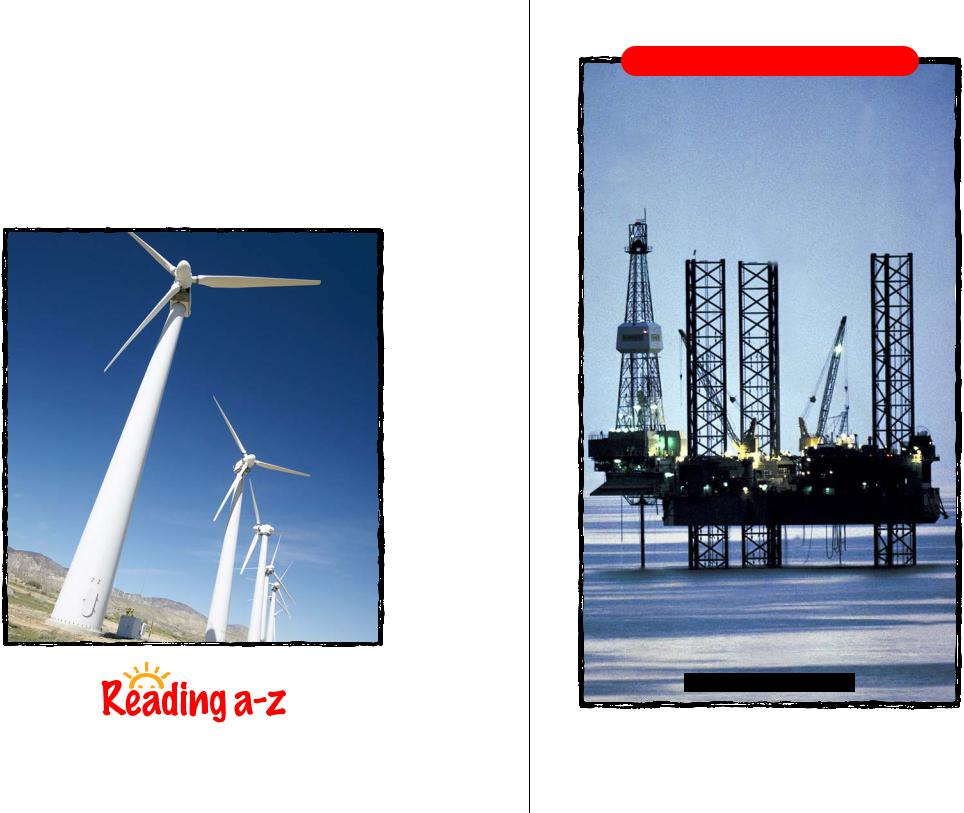
Energy Sources: |
LEVELED BOOK • Z |
|
|
The Pros and Cons |
Energy Sources: |
Word Count: 1,803 |
The Pros and Cons |
A Reading A–Z Level Z Leveled Book |
|
Written by David L. Dreier
Visit www.readinga-z.com |
www.readinga-z.com |
for thousands of books and materials. |
|
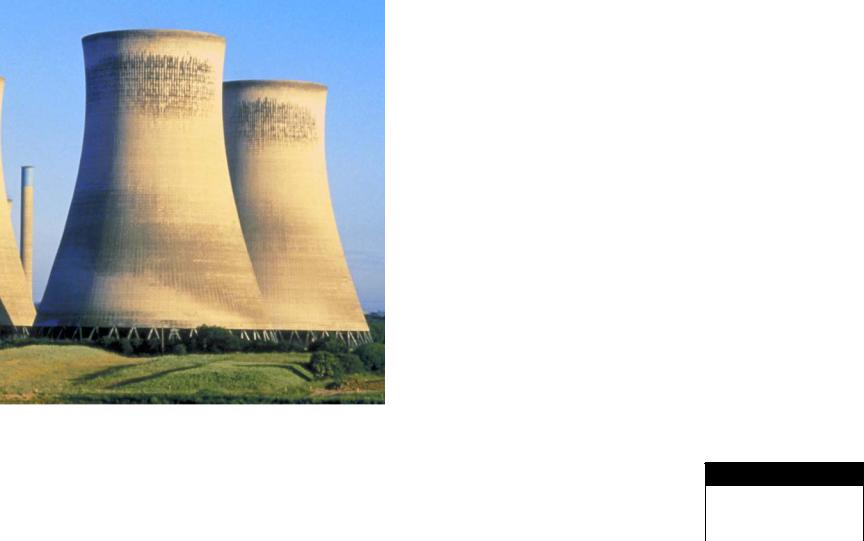
Energy Sources:
The Pros and Cons
Photo Credits:
Front cover, back cover, title page, pages 6, 8 (all), 9, 12 (top), 17, 18, 20, 22: © Jupiterimages Corporation; page 3: © Roman Snytsar/Dreamstime.com; page 4: © Monty Rakusen/Digital Vision/Getty Images; page 11: © Dreamstime.com; page 12 (bottom): © iStockphoto.com/Tim Pleasant; page 13: © iStockphoto. com/Sandra vom Stein; page 14: © Nick Rains/Corbis; page 15: © Paul Almasy/Corbis; page 16: © iStockphoto.com/ Richard Schmidt-Zuper; page 19 (main): © David R. Frazier/Photo Researchers, Inc.; page 19 (inset): © Ingram Publishing/SuperStock
Written by David L. Dreier Illustrated by Cende Hill
www.readinga-z.com
Energy Sources: The Pros and Cons Level Z Leveled Book
© Learning A–Z
Written by David L. Dreier Illustrated by Cende Hill
All rights reserved.
www.readinga-z.com
Correlation
LEVEL Z
Fountas & Pinnell |
U–W |
Reading Recovery |
N/A |
DRA |
50 |
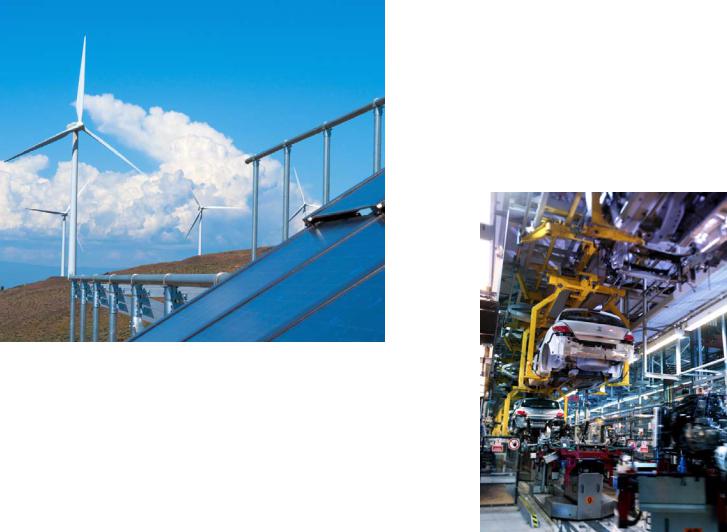
Table of Contents
The Endless Need for Energy.. . . . . . . . . . . . . . . . . 4 Fossil Fuels. . . . . . . . . . . . . . . . . . . . . . . . . . . . . . . . . 6 Hydroelectric Power. . . . . . . . . . . . . . . . . . . . . . . . 10 Solar Energy. . . . . . . . . . . . . . . . . . . . . . . . . . . . . . . 14 Nuclear Power. . . . . . . . . . . . . . . . . . . . . . . . . . . . . 18 Looking to the Future. . . . . . . . . . . . . . . . . . . . . . . 20 Glossary.. . . . . . . . . . . . . . . . . . . . . . . . . . . . . . . . . . 24 Index . . . . . . . . . . . . . . . . . . . . . . . . . . . . . . . . . . . . . 24
The Endless Need for Energy
The United States is a modern society.. Like all modern societies, it uses a lot of energy.. Scientists define energy as the ability to do work..
Many kinds of things can be called work.. Getting an automobile to move down a road or an airplane to fly is work, and so is producing
electricity or running the machinery in a factory..
The energy
|
used by the |
|
United States |
|
and other |
|
modern |
|
societies comes |
|
from many |
|
sources.. Much |
|
of it comes |
|
from the |
Machines in this car factory need energy burning of |
|
to build cars. |
fuels, such as |
|
|
coal and gasoline.. Other energy comes from the power of flowing water, from the light of the Sun, the wind, or from the splitting of atoms..
Energy Sources: The Pros and Cons • Level Z |
3 |
4 |
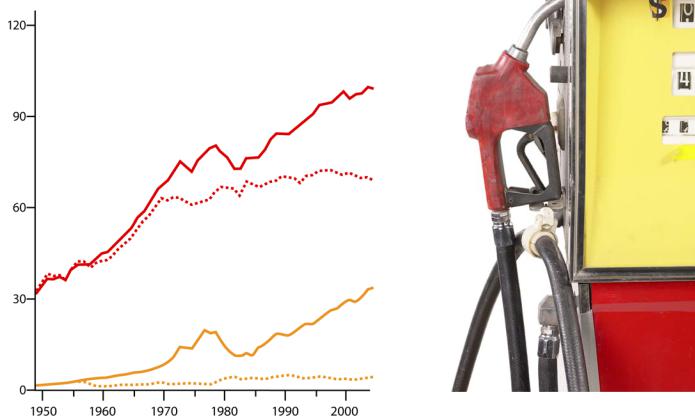
All energy sources have their pros and cons— their good points and bad points.. Modern societies have to make many decisions about how best
to produce energy.. The needs of the society have to be balanced against the need to protect the environment.. These choices are not always easy to make..
Energy use in the United States, 1949–2005
The United States uses more |
|
|
energy than it produces. |
|
|
What does this tell you |
Consumption |
|
about the energy future of |
|
|
the United States? |
|
|
BTU |
Production |
|
Quadrillion |
||
|
||
|
Imports |
|
|
Exports |
SOURCE: U.S. Energy Information Administration, Annual Energy Review 2005
Energy Sources: The Pros and Cons • Level Z |
5 |
Fossil Fuels
Fossil fuels—coal, oil, and natural gas—are a leading energy source around the world.. They are called fossil fuels because they were formed from the remains of plants and animals that died many millions of years ago.. Over time, great heat and pressure underground changed the remains into materials we use as fuel..
About 85 percent of energy used each year in the United States comes from fossil fuels.. Coal is burned in many power plants to produce electricity.. Fuels made from oil—such as gasoline, diesel fuel, and jet fuel— power our cars, trucks, and airplanes.. Most
homes use natural
Gasoline is a common fossil fuel. gas to provide
power for stoves and water heaters..
6
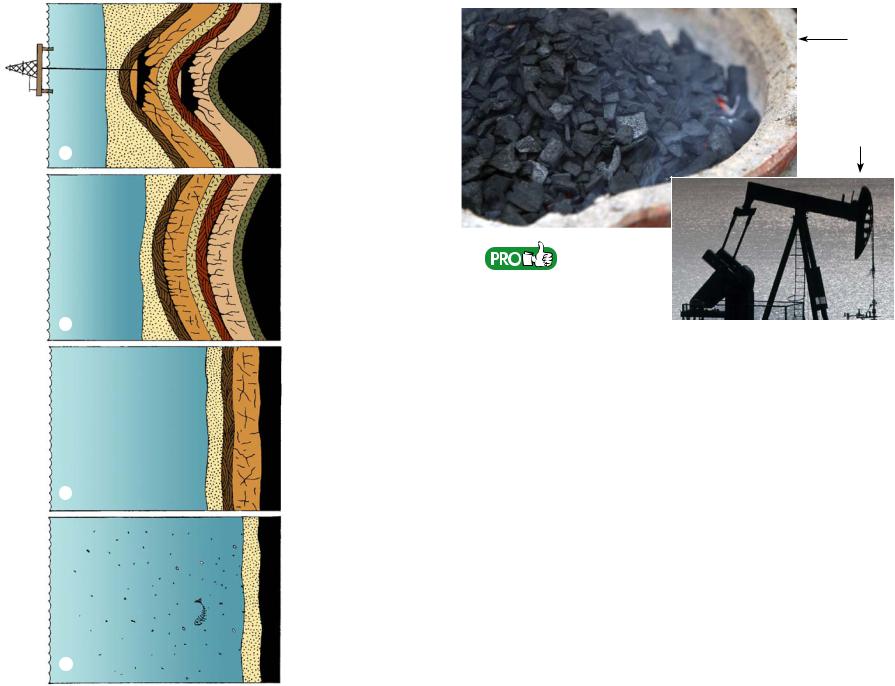
4
3
2
How Oil Forms |
1 |
Oil rises until it hits rock it |
can’t pass through. Oil rigs |
drill through this rock to pump |
out the collected oil. |
|
|
More time, more layers, and |
more pressure change the |
kerogen into oil, which begins |
to rise through tiny holes in |
the sedimentary rock. |
|
Time passes, more layers are |
added, pressure builds, and |
the buried plant and animal |
material changes to kerogen |
while the sediment forms into |
sedimentary rock. |
Marine plants and animals |
die and sink to the ocean |
floor. They mix with dirt and |
sand to form a sediment layer. |
|
|
A close-up of coal
A pump jack is used for extracting petroleum from an oil well.
One of the main advantages of fossil
fuels is that they are abundant—found in many places and in large amounts.. In addition, they contain a lot of usable energy.. Coal is especially abundant.. The United States has enough coal to last another 200 to 300 years..
A special advantage of natural gas is that it burns very cleanly.. When natural gas burns, it produces mostly carbon dioxide and water vapor..
Oil’s main advantage is that it burns efficiently—meaning that little is wasted in the change to energy.. Also, the refining process that produces gasoline and diesel fuel produces other petroleum products used in crayons, bubble gum, eyeglasses, and even artificial heart valves..
Energy Sources: The Pros and Cons • Level Z |
7 |
8 |
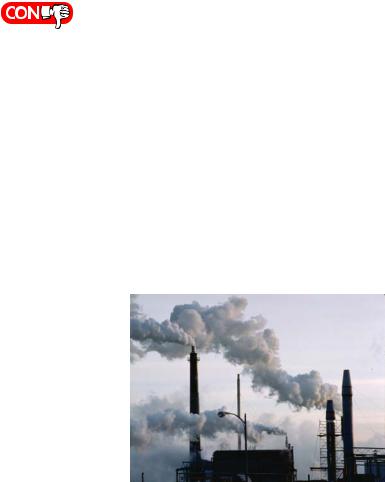
All fossil fuels are essentially nonrenewable energy sources because nature cannot create enough to keep up with demand.. Many experts think that the world’s oil wells will be empty in a few decades.. But, even before then, the oil supply will be too small to meet global demands..
Also, fossil fuels (except for natural gas) produce pollutants.. Cars, factories, and many power plants release harmful chemicals into the air.. Since fossil fuels are burned, air pollution will continue to be
a problem..
Another problem is called the greenhouse effect.. Gases released from burning fossil
fuels trap more heat in Earth’s atmosphere than would be trapped naturally.. This heating up of Earth’s atmosphere is called global warming..
Scientists think carbon dioxide contributes most to worsening the greenhouse effect, so even natural gas adds to the problem..
Hydroelectric Power
Water is widely used to produce electricity.. You might wonder how electricity can be produced using water.. The answer is by building dams.. A dam is a huge, wide wall, usually made of concrete.. It is built across a river to hold back the river’s flow.. The river’s water then fills up
a large area behind the dam, forming a lake or reservoir..
Water from the lake is released through the bottom of the dam.. The water moves very fast.. It passes through big machines called turbines.. Fanlike blades inside the turbines spin when water rushes through them.. The turbines are connected to other machines, called generators, making them spin too..
Inside a generator, a shaft is surrounded by giant magnets.. All around the shaft and magnets is a huge coil of wire.. When the turbines spin the shafts and magnets of the generators, they move electrons in the coil of wire.. The movement of these electrons creates an electric current.. Electricity made at dams is called hydroelectric power.. Hydro is a prefix (first part of a word) that means water..
Energy Sources: The Pros and Cons • Level Z |
9 |
10 |
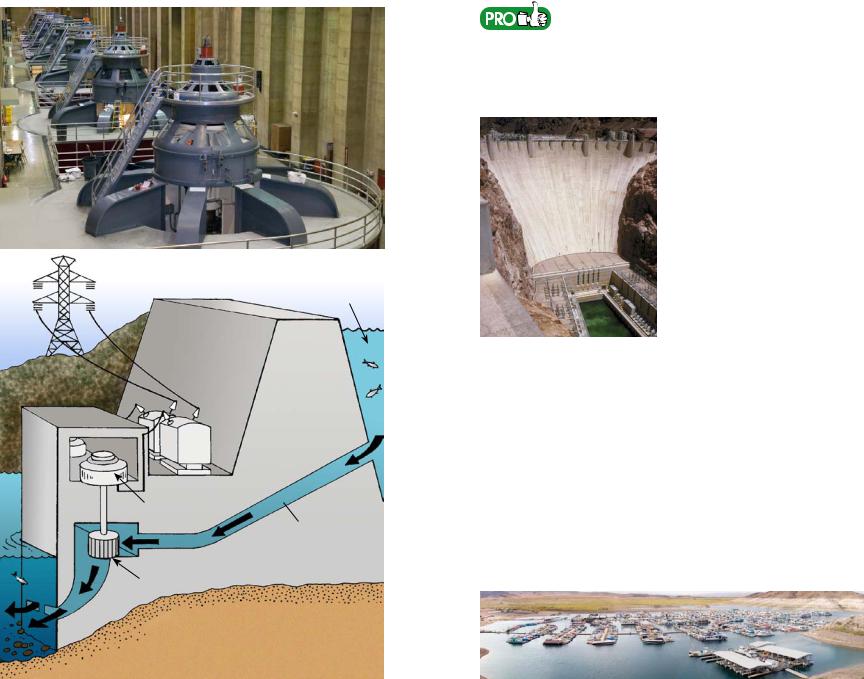
Generators inside a dam
How a Dam Works
reservoir
dam
power lines 
generator  penstock
penstock
turbine
Water from the reservoir flows into the penstock. As the water rushes downward, it turns the blades of the turbine before emptying into the river.
Dams produce a great deal of needed electricity.. There are more than 2,000 hydroelectric dams in the United States.. They produce about
10 percent of the nation’s electricity.. Hydroelectric dams produce about 20 percent of the world’s electricity..
Hoover Dam blocks the Colorado River, creating Lake Mead, one of the world’s largest artificial lakes.
Dams have many other uses too.. They prevent flooding by storing the water from heavy rain and
snowmelt, and gradually releasing it later..
Dams also create many opportunities for recreation, such as boating and fishing in the lakes they create.. In addition, the lakes provide water for homes and industries as well as provide water for farmers to irrigate their crops during drier times of the year..
Lake Mead’s boat docks
Energy Sources: The Pros and Cons • Level Z |
11 |
12 |
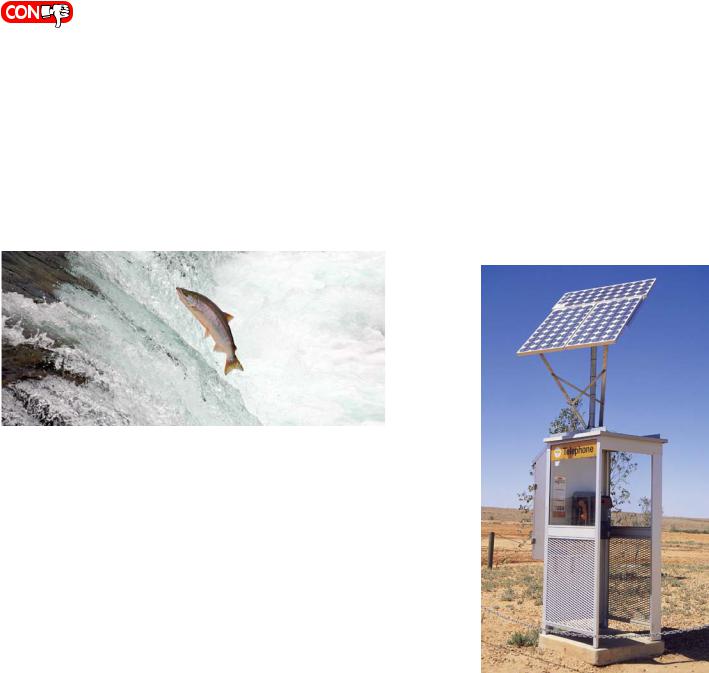
Flood prevention is good for people, but not so good for the environment.. Rivers are supposed to flood.. Flooding produces sediment, which is
a mixture of gravel, sand, and topsoil.. Sediment deposited by floods keeps the soil rich in farmlands located near rivers.. When a river is dammed, it cannot renew the soil on the land around it..
Salmon swimming upstream
Dams also block the route for fish that swim up and down rivers.. In the U..S.. Pacific Northwest, dams have been a serious problem for salmon.. Every three to five years, salmon
swim from the ocean up rivers to their birthplaces to lay eggs.. Dams make it difficult for salmon to swim up and down rivers.. As a result, salmon populations have severely declined in the past 100 years..
Solar Energy
Sunlight carries huge amounts of energy.. You can feel the Sun’s energy when sunlight warms your skin on a summer day.. To capture the Sun’s energy, scientists have developed solar cells, called photovoltaic (FOE-toe-vole-TAY-ik) cells.. These cells convert sunlight into electricity..
When sunlight hits a solar cell, the cell absorbs some of the light energy.. Particles in the solar cell move faster, and the movement of these particles creates electricity..
In some places, large panels of solar cells harvest sunshine to make electricity for homes and businesses.. Solar cells have been placed on cars and appliances, too..
A solar panel is used to provide energy to this phone booth.
Energy Sources: The Pros and Cons • Level Z |
13 |
14 |
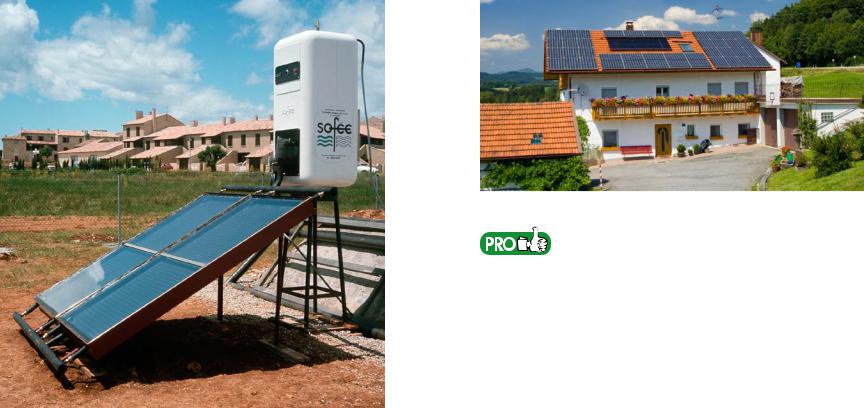
This solar water heater is one of many used to heat water for the town of Méjannes-le-Clap, France.
A solar heat collector uses the Sun’s energy to heat water.. These solar heat collectors are often placed on rooftops.. Water circulates through pipes in the panels, and the Sun’s radiant energy heats the water.. The heated water is pumped into a building through more pipes.. The heat leaves the water and heats the inside of the building.. Then the cooled water returns to the rooftop to be heated again..
Rooftop solar panels provide this house with energy.
In some areas of the world, such as the southwestern United States, there are many sunny days.. In these places, solar cells and solar panels can produce lots of electricity and heat.. Since the Sun sends abundant free energy streaming toward Earth 24 hours a day, people in many parts of the world, not just the sunniest
places, have mounted solar cells and solar panels on the roofs of their houses or businesses to lower their energy costs..
Experts say that huge installations of solar panels in sunny regions could generate enough electricity to supply an entire country.. Capturing this energy can help overcome our diminishing energy supply.. New ways to capture this energy are being developed all the time to maximize efficiency..
Energy Sources: The Pros and Cons • Level Z |
15 |
16 |
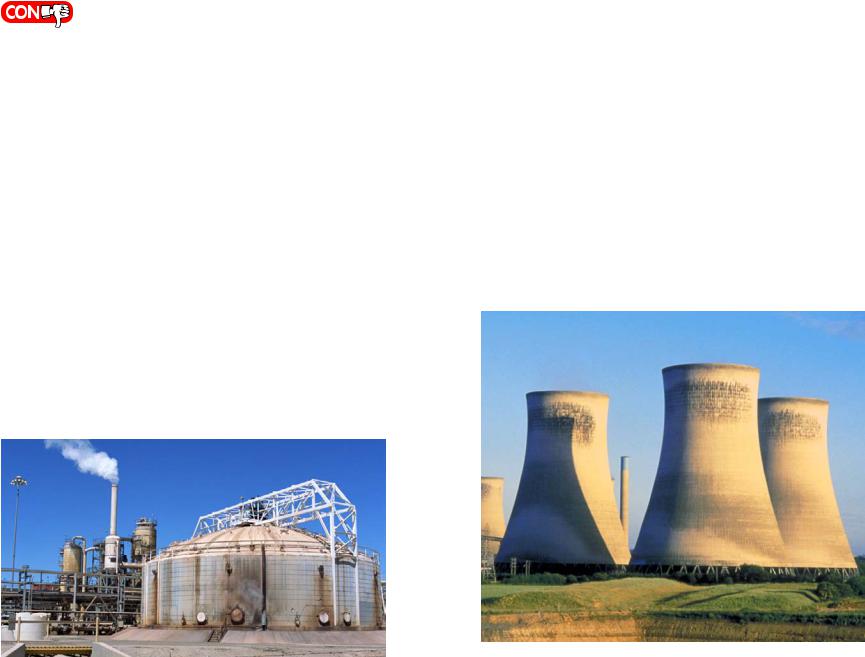
There are two main problems with solar cells.. One is that they are very expensive to manufacture.. Their cost makes hydroelectric and fossil-fuel power plants a cheaper source of energy.. Until inexpensive manufacturing is developed for solar cells, this free energy source will continue to come at a high cost to capture and convert to electricity..
The second problem is that not all areas of the world get abundant sunlight.. Other sources of energy would be needed as a backup to the solar cells, which adds to overall energy costs..
Some people who live near houses that use solar cells and solar panels think the rooftop systems are ugly.. They believe the look of the solar systems will decrease the value of their homes..
Nuclear Power
Nuclear power plants unlock the energy inside atoms to generate electricity.. Each splitting of an atom releases energy.. An atomic bomb explodes by creating a very rapid chain reaction.. A nuclear power plant uses the radioactive element uranium to create a slow, controlled chain reaction..
The energy released by breaking apart uranium atoms is used to heat water into steam.. The steam is then used to generate electricity in much the same way that coal power plants produce it..
Power plants could serve as backups for solar farms.
Cooling towers keep the core of a nuclear power plant at a safe temperature.
Energy Sources: The Pros and Cons • Level Z |
17 |
18 |
